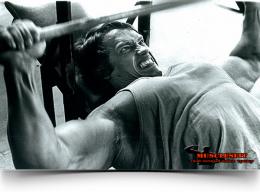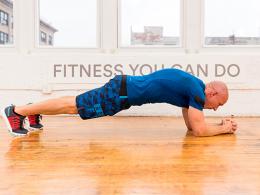How to properly perform the bench press. How to increase the bench press
In all strength sports, training includes the bench press. But not only in powerlifting and bodybuilding, it is the main exercise. In fitness, it is also constantly used to pump a large muscle group, even fragile women.
Exercise Definition
In sports terminology, the bench press means a horizontal exercise with a barbell, during which it is raised from the chest to the level of straight arms.
This exercise trains the main muscle groups of the chest and shoulder girdle. Depending on the variety, the emphasis can be placed both on all muscles and on individual groups.
A variety of performance options allows you to use this exercise both for building muscle mass and for giving them a beautiful relief shape.
Along with its effectiveness, the occupation is characterized by injury risk. Therefore, it should be performed either on special equipment or with the help of an insurer who, at the time of fatigue, will help remove the barbell from the chest. Otherwise, even an experienced athlete can be crushed by the significant weight of the projectile.
Technique
Starting position - lying on your back on a gymnastic bench. The legs are spread and rest on the ground. The athlete removes the barbell from the safety rack or takes it from the assistant with outstretched arms.
Grip width plays a big role. The farther apart the hands, the less the amplitude of walking the bar. In this case, mainly the pectoral muscles work. For the load on the arms and shoulder girdle, it is worth using a bench press with a narrow grip.
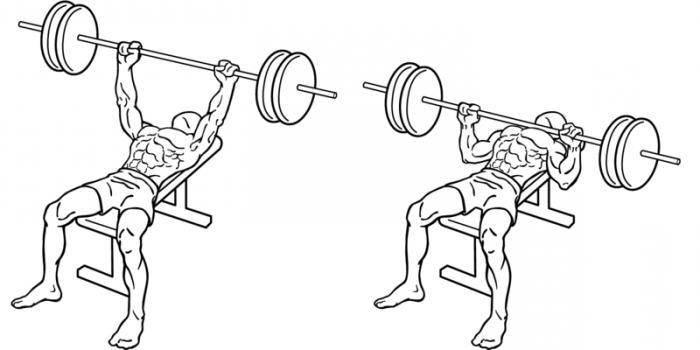
Lying athlete slowly lowers the bar to the chest. It is important that it does not dangle in different directions. Ultimately, the bar falls on the athlete and immediately rises up on outstretched arms. In this case, the shoulder blades should be brought together in order to maximize the use of the deltoid muscle.
Basic Mistakes
Since the bench press is one of the dangerous exercises, it is worth avoiding a number of possible mistakes that can cause injury.
- Warm up, warm up and warm up again. The load on the muscles and joints during the bench press is large. Without proper preparation, there is a high chance of injuring yourself.
- Do the exercise with a partner, especially if you are a beginner. Even insurance restrictions may not help if you have not calculated your own strength.
- The correct amplitude of movement of the barbell is the basis of the exercise. Start with a light projectile weight to master the bench press and learn how to feel the working muscles. Only after that, start strength training.
- Proper grip is essential. The bar must be taken in a closed ring. Otherwise, it may slip out and fall on the chest, stomach or head. At the very least, it will be unpleasant to get hit even by a 20-kilogram weight.
- You can not twist the joints of the hand. From this, the load on them increases significantly, which means that the risk of dropping the barbell will increase. Also, watch the position of your forearms. They should be parallel, and at the lowest point they should occupy a strictly horizontal position.
Varieties
This exercise has many variations. The classic is the wide grip bench press. Everything else is a variety for a better study of a certain group of muscles of the thoracic region.
Instead of a bar, other devices can be used. The dumbbell bench press is very effective. Provided that it is performed correctly, the muscles of the shoulders and arms are well worked out.
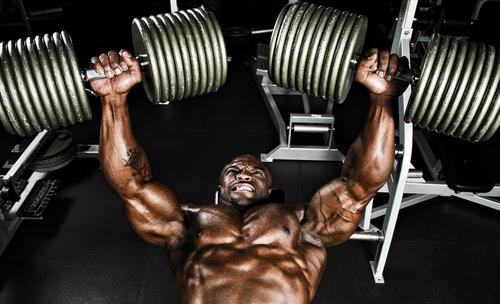
You can use an incline bench for this exercise. The higher the head, the greater the load on the arms, and vice versa, in a position where the body is higher than the shoulder girdle, the load goes to the pectoral muscles.
By the presence of an assistant, a bench press in a power rack, a bench press with racks and a bench press with a safety net are distinguished.
According to the technique of execution, there is a bench press in “touch”, a classic sports version, boosters, bench press in the bridge.
Also, the exercise is distinguished by its focus on individual muscle groups with different types of grip:
- direct, reverse;
- wide, medium and narrow.
Close Grip Press
Over time, athletes begin to use a close-grip bench press. In general terms, the technique of its execution practically does not differ from other types. The main feature is that the grip of the bar is carried out almost in the center of the neck.
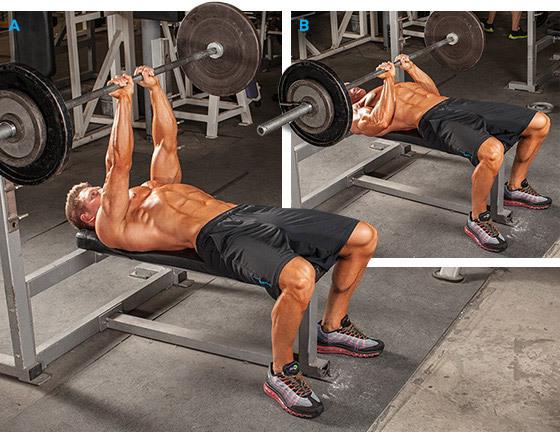
This method greatly unloads the muscles of the shoulders and forearms. The upper and deep pectoral muscles and the lower deltoid work perfectly.
In competition, this exercise is not practiced for several reasons. The main one is the large amplitude of the stroke of the rod. Yes, and the load is local, and during the competition you need to show general physical fitness.
Using this method in training, it is easy to increase muscle mass and volume. Anyone who knows this exercise does not wonder how to increase the bench press. This exercise is great for building strength and endurance. After it, the classic bench press with the same weight will no longer be so effective, which entails an increase in it.
Incline Press
A special variation of the exercise in question is the bench press on an inclined plane. For its implementation, an athletic bench with an adjustable inclination of the surface is used. The level of load on certain muscle groups depends on its angle.
By performing a bench press with your head above your body, you significantly shift the center of gravity towards the upper chest and shoulder girdle. The pectoral muscles are practically not involved in the exercise. This is a good option when you need to focus specifically on the shoulders and forearms.
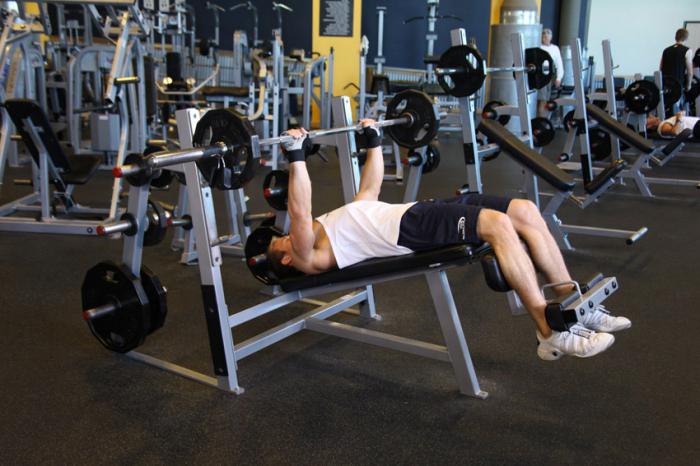
To work out the pectoral muscles as much as possible, it is worth lowering the head and chest below the waist and performing a bench press. The grip is selected as wide as possible. You should be attentive to the condition of the brushes. In this position, there is a high probability that the bar may go back, which means that there is a risk of turning the fists in the opposite direction.
Bench press on an incline should not start with a lot of weight. To begin with, it makes sense to try with the most comfortable load, gradually increasing it.
We press and press from a dead center
In gyms, it is also common for athletes to press and press from a standstill. These are exercises in which the barbell is lowered not to the chest itself, but to a certain point above it.
Not every time you can perform a bench press. Upper section training should be an alternation of strength and endurance exercises. The boost is performed in such a way that the athlete lowers the bar on his hands to a certain height, about half of its stroke, and then lifts it up again.
Dead center presses are an easier version of presses. The athlete uses racks for their performance, on which the supports are installed at the desired height. The bar rises on the hands up, and then falls back into place. This is the safest way to do bench presses. It is with his help that novice athletes will understand how to increase the bench press without being in danger of injury.
Competitive form
In powerlifting, bench press competitions almost always take place. The technique for performing this exercise is slightly different here. Firstly, “touch” exercises are prohibited. The lifter may lift the weight only after the referee has given the command to do so.
Secondly, liberties are allowed by the type of grip. It is logical that most athletes choose a wide version of it: both muscles work more and the height of the bar is lower.
Thirdly, the bridge position is allowed. The athlete arches his body in such a way as to raise the chest as high as possible, reducing the distance from the chest to the bar with outstretched arms.
In addition, at competitions, options are possible when bench press is performed without equipment. The standards for such exercises are slightly lower than for equipped ones. They range from 1-2 body weight of an athlete, depending on his qualifications and sports association.
Bridge training
For professional athletes in this sport, bridge training is of great importance. She should devote no less time than the bench press itself.
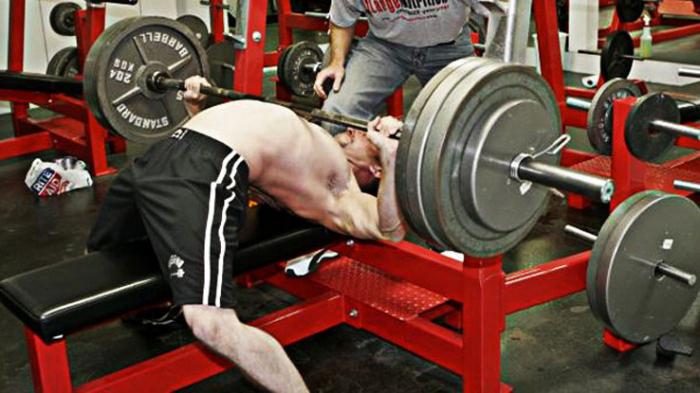
The difficulty lies in the fact that pumping muscles steals their elasticity. Therefore, athletes after each session should be engaged in stretching, especially the muscle corset.
The height of the deflection depends on this, and hence the time after which fatigue occurs. To train the bridge, different exercises from yoga are used. Of particular importance is the “Cobra” pose, in which the athlete tries to achieve maximum deflection of the lower back, resting his outstretched arms on his legs lying on the floor with his knees down.
In competitions, the bridge is used not only to reduce the distance. The athlete has 3 points of support: shoulder blades, coccyx and legs, standing almost under the back. This makes it possible to absorb a huge weight with the whole body.
Bench press records
It is difficult to say who is the absolute champion among those who have ever performed a bench press. The record in the Guinness Book in this sport was recorded in special equipment - a T-shirt for bench press. It belongs to the American athlete R. Kennelly and is 486 kg with its own weight of 140 kg. Without equipment, this powerlifter presses only 323 kg.
Among women, the American T. Rinewater-Grimwood is also considered a record holder. In 1994, she was able to squeeze 180 kg, which is almost 100 kg more than her weight.
The weightlifter P. Anderson is considered the first world record holder. He set the bar at 280 kg without a jersey in the mid-50s of the last century. And although it was believed that the Soviet athlete Yu. Vlasov was stronger than him, no one managed to beat this record for a long time. At the same time, Anderson himself never bet on the bench press. He specialized in other strength exercises, especially squats. It was not a problem for Anderson to squat two or three times with a weight of 510 kg. His hips were more than 1 m in girth.
Emergency exit from the exercise
Finally, it is worth mentioning that it is not always possible to engage in insurance. In this case, it is better to do a dumbbell bench press. They do not create a danger of crushing the athlete to the bench with their load. If, nevertheless, a decision is made to work with a barbell, you should never rely on your own strength. Leave an escape route for yourself.
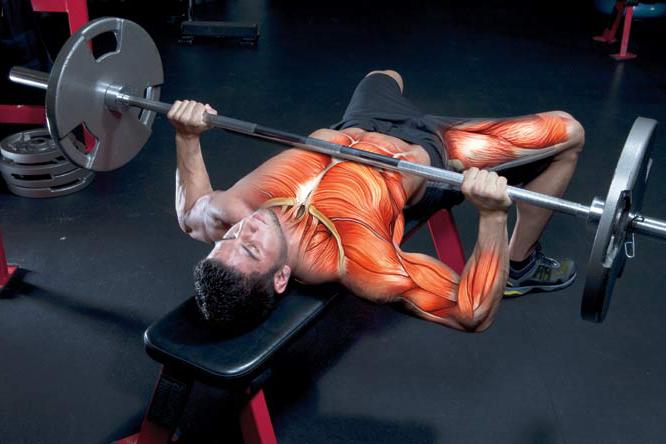
No need to fix pancakes on the bar with clamps. When the strength leaves the athlete, you can gently tilt the bar to one side so that the weight comes off it. At this time, you should be careful and hold the bar very tightly, otherwise the outweighed side will fly away in the opposite direction.


